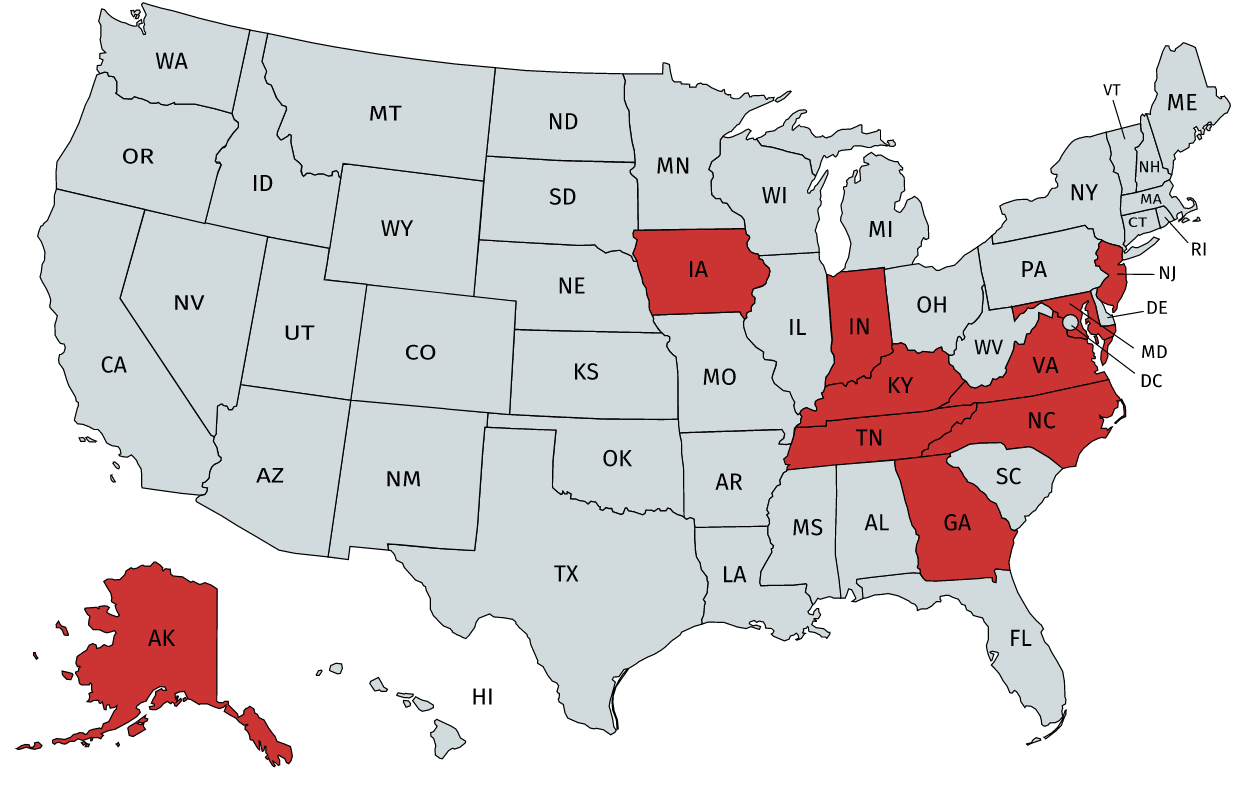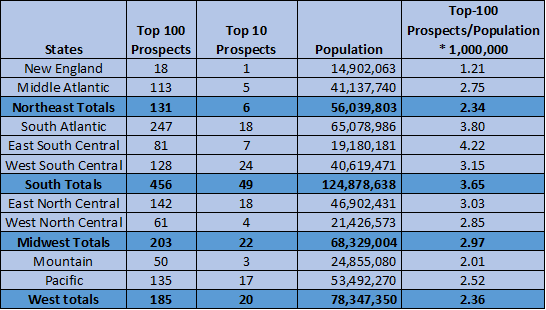Analysis of NCAAW Recruiting Part One: Where do the top prospects come from?
Where do the top recruits in Women's College Basketball come from? We examined the top prospects of the past ten years to determine the most talent-rich parts of the country.
In the 2002 movie classic, “Catch Me If You Can,” Leonardo DiCaprio is a criminal mastermind on the run from FBI Agent Tom Hanks. After a particularly close endeavor, DiCaprio’s character claims that the reason he was able to escape successfully was, “The same reason the Yankees always win. Nobody can keep their eyes off the pinstripes.” Hanks, a more pragmatic and level-headed voice, answers back with the correct answer, “The Yankees win because they have Mickey Mantle.”
Well, what was true in 1963 about baseball carries true across all sports in all eras. The Oregon Ducks won because they had Sabrina Ionescu, the Baylor Bears won because they had Brittney Griner, the UConn Huskies won because they had….. well take your pick of UConn greats. Coaching, chemistry, and teamwork all still matter. They’re the difference between a Sweet Sixteen appearance and a Final Four run. They’re the margin between a national title and loss in the semifinals. But at the end of the day, the difference between the nation’s elite programs and those still searching for relevance is talent. The best way to acquire that talent is through recruiting.
Recruiting is what drives collegiate sports. The correlation between the top teams in the nation and the highest ranked recruiting classes from a few years ago is staggeringly high. South Carolina, Oregon, Baylor, Mayland, and UConn finished this season as the AP Poll’s top five teams. Over the past four years, they’ve combined for eight of the 12 top-three classes according to ESPN. Teams put significant resources, time, and effort into persuading the top talent to play for their school. However, perhaps the most important factor in recruiting is one that can’t be controlled — geography.
I examined the espnW HoopGurlz Class Rankings from the past ten years to determine where the best players are coming from, which programs recruit specific regions the best, and finally, what areas are over/undervalued by ESPN’s top 100 rankings. In part one, we’ll look at the location of the top recruiting hotbeds in the nation and how that may impact the college basketball landscape.
A disclaimer, like any scouting rankings, ESPN’s top 100 is far from infallible. All programs have their own boards with their own rankings based on their coaching staff’s assessment. Baylor’s No. 6 ranked prospect might be No. 22 on ESPN’s list. However, ESPN’s Top 100 is the most prominent, publicly available source, and it is more than sufficient to give us a baseline of the overall landscape. Population figures are based on projected census data for June 2019. Changing demographics over ten years makes it impossible to pinpoint one specific population figure, but in general, we can get a reasonable idea of per-capita statistics based on 2019’s numbers. Also important to note: There have been 25 top-100 international prospects over the past ten years. They have not been included in this analysis.
Which states do the top recruits come from?
In terms of raw volume, California and Texas are the unsurprising dominant forces of collegiate prospects. The two states account for over 20% of the top-100 prospects over the past ten years. They also account for more than one-third of the top-ten prospects, with Texas alone producing 21.
Considering their populations, you probably didn’t need an article to let you know that California and Texas dominated recruiting. However, after slot two, it gets a little more interesting.
Georgia and Florida sit a tier above the rest of the states, each amassing 58 top-100 recruits over the past ten years. Florida has the third-largest population in the country, and its third-place ranking shouldn’t be a surprise. However, Georgia yielding 58 top-100 recruits, with a population less than half that size, speaks to the talent level coming out of the state. New Jersey and Maryland also manage to rank in the top ten with populations of under ten million.
Drawing broad conclusions from the top-ten prospects is a much more difficult proposition. The sample size of just 100 players makes the leaderboard extremely volatile. Ohio, the third-ranked state in terms of top-ten prospects, went eight years with only two top-ten players and four years with zero players in the top ten. Perhaps the biggest thing we can learn from the top-ten rankings is how one or two elite-level players can change the entire recruiting landscape.
Which states produce the most compared to their population?
While it’s useful to know which states produce the most prospects, perhaps the more important and interesting question is “Which states produce the most talent relative to their population?” Which states have the most talent on a per-capita basis?
If we look at total top-100 prospects divided by population (multiplied by a factor of 1,000,000 to produce more user-friendly numbers), we can see which states are the most talent-rich per person.
Maryland seems to be a tier of its own, producing 6.45 prospects per one million people. A handful of states – Georgia, New Jersey, Kentucky, Tennessee, Iowa, Indiana – aren’t too far behind, with a reasonable drop after that. (With all due respect to Ruthy Hebard, Alaska’s three total prospects don’t have much of an impact on the overall landscape of recruiting.) Virginia and North Carolina round out the top ten with per-capita values that are significantly closer to half of Maryland’s 6.45 prospects per million than to Maryland’s value.
But when analyzing the top states, what jumps off the page the most is the fertile hotbed that exists in the Southern/Middle Atlantic region of the country. The top five states in terms of per-capita talent are all within 700 miles of one another. Eight of the top nine (again, not counting Alaska) are east of the Mississippi, with Iowa bordering the river itself. A heat map of the selected areas highlights how closely located the most talent-rich areas are to one another.
Which leads to another question:
What are the top recruiting regions across the country?
It’s incredibly difficult to define the top “areas” of recruiting talent. Most people would agree that Tennessee is “close” to Ohio. Tennessee also borders Georgia. Yet, very few people would argue that Ohio and Georgia are similar geographically. Even within states, Northern California looks and operates much differently than Southern California. Truth is, regions are much more malleable and flexible than what we can define on a map. Yet, in order to take an objective look at the top recruiting parts of the country, we are required to make distinctions.
The U.S. Census Bureau breaks the country into four “regions” and nine “divisions.”
Unsurprisingly, based on what we’ve learned from the top recruiting states, the South is the most dominant region, with the Eastern side doing the heavy lifting. Four of the top five states in terms of per-capita prospects are located in the Southern region of the United States. The South has also completely dominated the elite prospects, managing to provide over half of the nation’s top-ten prospects the past ten years. It’s not a coincidence that six of the final AP Poll’s top ten teams are also located in the nation’s Southern Region.
Comfortably in second place is the Midwest. The country’s heartland has produced 18 more top-100 prospects than the West over the years despite a significantly lesser population. Although the region doesn’t have quite as many top-producing states as the South, it does have a bevy of quality states such as Iowa, Indiana, Ohio, and Minnesota.
The Northeast and West are a step behind, essentially tying for third/last place. The West doesn’t receive major contributions from any state other than California. The Northeast is hurt by Pennsylvania playing a significantly smaller role than you would expect while also getting very little from the entire New England division. UConn’s success looks even more impressive when you consider the lack of successful recruits in their backyard (more on that later).
Recruiting fuels top programs, and schools located near talent-rich states and regions have an inherent advantage over the rest of the nation. Those that aren't need to find ways to steal and poach players from outside their locale. Recruiting is becoming more national and some schools have built success with players from outside their immediate reach. Still, on the court and in recruiting, it’s always helpful to have a home-field advantage.
In part two of our three-part series, we’ll take a look at which schools are able to keep their homegrown talent, which programs have found success recruiting nationally, and where some coaches were able to develop an unlikely pipeline in other parts of the country.







